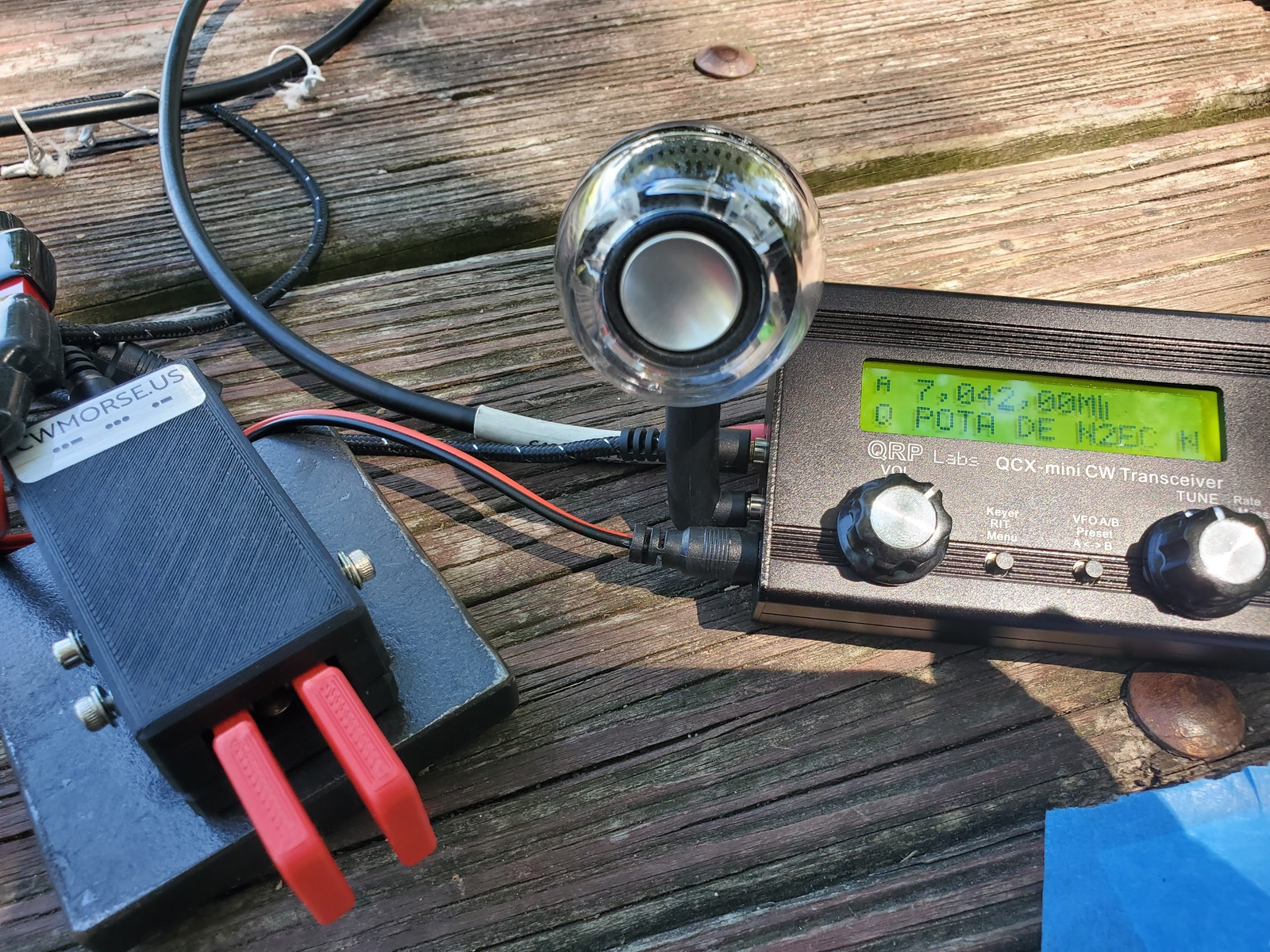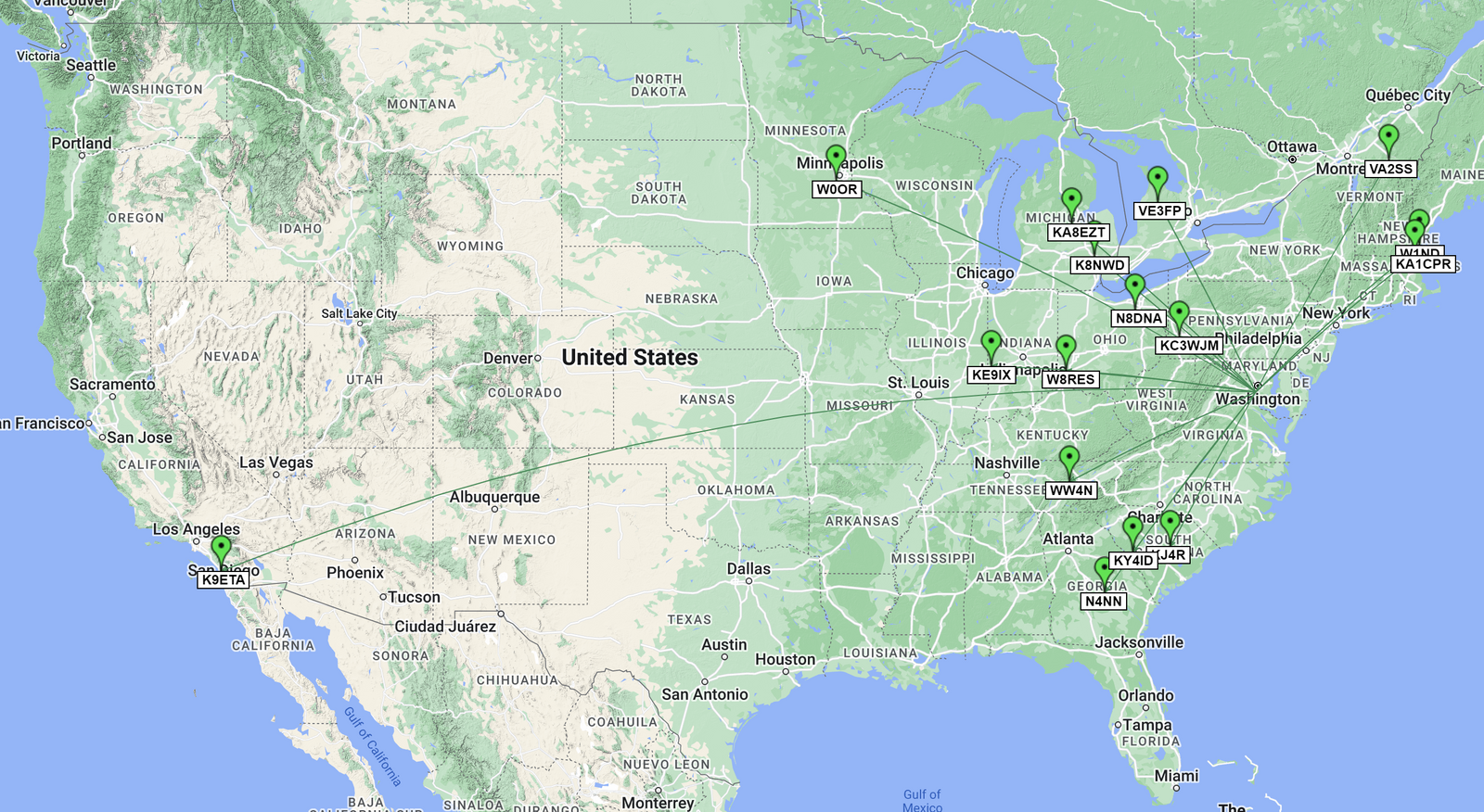POTA Activation #26: A 4-fer with Gersohn and a New Radio at George Washington Memorial Parkway, Captain John Smith Chesapeake NHT, Star Spangled Banner NHT, and Potomac Heritage NST (VA) (8/20/2022)

I've had a bunch of amateur radio projects that have been stacking up over the Summer, and I finally had some time to work on one of them: the QCX mini from QRP Labs. The QCX mini is a single band QRP (5 W) CW transceiver (mine was built for the 40 m band). I had seen a lot of reviews of the radio and was amazed with the quality of its receiver and its compactness. The radio is astonishingly inexpensive as well, coming in under $60 for the radio, and under $100 including the case and all the add-ons. I was excited to build the radio, and with a couple days of work I had assembled, aligned, and tested it successfully. I made contacts on my home antenna with an external antenna tuner was amazed with the quiet that I was hearing on the band. Where my Kenwood TS-440S had significant noise, the QCX mini had near silence. CW just popped out loud, clear, and easy on the ears.
The 5 W definitely made things more of a challenge at home, but after repeated CQs I made some contacts, including a Canadian contact and great rag-chew with a station in Maryland. I was also getting solid reports on the Reverse Beacon Network. When I connected it to the QRP Labs Dummy Load, it estimated that I was getting the full 5 W output, so I was excited to get it into a park, put it through its paces, and enjoy the "+6dB" that comes from being on the POTA spotting network.
My buddy Gersohn (KO4IUK) had gotten back from a vacation on the West coast and we had a beautiful day forecast on Saturday, so we decided to meet at Belle Haven Park on the George Washington Memorial Parkway. Due to the location of our operating position we were within 100 feet of 3 other parks: Captain John Smith Chesapeake NHT (on the Potomac), Star Spangled Banner NHT (on the Potomac), and the Potomac Heritage NST (on the Mount Vernon Trail). That made this activation a 4-fer.

I brought my QCX mini and my Icom IC-705 so I could operate on other bands as well. Gersohn was also interested in getting more familiar with FT8, so I made sure I could operate my station digitally to show him how I've activated on FT8 as well. We got an early start and quickly got our antennas up into the trees. I used my throwline and got a nice inverted-v setup and Gersohn used his air cannon and got his line into two trees using all 175' of line! You can see the tree he used in the picture above and he got to the very top of it. He used his Nelson 49:1 matching network into an end-fed half-wave and it performed like a champion with low SWR on the bands. Shortly after getting up and running Gersohn made an SSB contact with Alaska! Can't beat that.
I used my trusty MFJ 1984-MP end-fed half-wave antenna and was pleased to see that on 40m I was getting an SWR of around 1.3:1 -- plenty good to go direct into the antenna without a tuner for my QCX mini. I got everything connected, programmed the keyer, and started calling CQ. I got my first two responses to my CQ in relatively short order with my first coming from Ohio and my second coming from Pennsylvania. Not bad for 5 W. I kept calling and got a response from a station that QRZ says was in California -- a bit of a surprise on 40 m, but I'll take it. Finally after calling CQ for another 10 minutes I got contact number 4 in Tennessee. I kept calling, but the band seemed pretty dead, so I decided to take a pause with the QCX and setup my IC-705.
I wanted to see if it was the 5 W or the band, so I gave 40 m SSB a go and made contacts with New Mexico, Virginia (about 6 miles away), Ohio, Ontario (Canada), and North Carolina. The going was slow, with those contacts taking about 29 minutes, so I had my answer: it was the band. So I decided to move over to 20m and start calling CQ on CW and was answered by Georgia, Texas (x2), Oklahoma, and after a bit of a delay Pennsylvania. I had made my activation, so the pressure was off a bit. I mentioned to Gersohn that I had been able to make contacts on 60 m at other parks using a tuner and a 40-10 EFHW, so we gave it a try on his antenna and sure enough, it tuned up and I was able to make a contact with North Carolina bringing the number of bands I had worked in both Captain John Smith Chesapeake NHT and the Star Spangled Banner NHT to 9.
Next I took a break in operating to try to lend a hand to Gersohn in getting his digital setup on the air. He was having some really strange noise coming in on his receive audio, and we weren't able to figure out what was going on. We went back to my IC-705 and I showed him my setup for FT8, this time on 40 m as I had some RFI issues on 20 m causing my radio to disconnect from the USB connection when I was transmitting. FT8 has a bit of a learning curve as the user interface isn't the most intuitive, so I was happy to show how I operate. I was able to make contact with stations in Connecticut, Virginia (this time just 4.4 miles away), Ontario (Canada), Texas, Ontario again, New York, and Tennessee. We tried to get things rolling on his FT8 setup after working those stations, but for this day it was not to be.

Emboldened by the success on FT8 on 40 m I decided to hook up my QCX mini one more time and see if I could get enough contacts to have had a full activation on it, if I had not brought the IC-705 along -- maybe the band had improved. And quickly I had my answer, it had gotten better. I had a park to park with Ontario (Canada), followed by contacts with South Carolina, Indiana, Ohio, South Carolina again, Georgia, New Hampshire, Quebec (Canada), Massachusetts, Michigan, Minnesota, and another Michigan contact. A great run on 40 m with just 5 W. What a great little rig.
Before we packed up, Gersohn and I pulled out our VHF radios and made a couple park to park contacts (from the same park) for fun. I tried calling out on the calling frequencies as well, but today there were no takers aside from Gersohn. All told I made 22 contacts on CW, 7 on FT8, and 7 on SSB for a grand total of 36 contacts. Of course, since this was a 4-fer 36 becomes 144 contacts in all. A fun day out in the park with a good friend.

QCX Mini 5W Activation Map: Green Pins = CW, Green Lines = 40m

Complete Activation QSO Map: Red Pins = SSB, Green Pins = CW, Blue Pins = FT8 / Black Lines = 60m, Green Lines = 40m, Blue Lines = 20m
Gear used in this activation
- Icom IC-705
- QCX Mini (40 m version)
- Leadsound Crystal 3W Speaker
- MFJ 1984 MP End-Fed Half Wave Antenna
- Nelson 49:1 End Fed Half Wave Antenna
- LDG Z100 Plus
- CW Morse Pocket Double Paddle Morse Code Key with Magnets
- CW Morse Steel Base for Pocket Paddles
- RigExpert Stick Pro Antenna Analyzer
- Icom LC-192
- Bioenno 12V 6Ah LiFePO4 Battery
- Sony Headphones
- Dell XPS 13 Laptop
- Rite in the Rain Notebook
- Zebra DelGuard Mechanical Pencil

